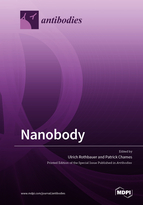Nanobody
A special issue of Antibodies (ISSN 2073-4468).
Deadline for manuscript submissions: closed (30 November 2018) | Viewed by 142321
Special Issue Editors
Interests: nanobodies; antibodies; recombinant antibody-technologies; phage display; live cell imaging; high content analysis; molecular imaging; theranostic
Special Issue Information
Dear Colleagues,
Since their first description 25 years ago, single-domain antibody fragments, derived from heavy-chain-only antibodies of camelids, so-called nanobodies, have emerged as attractive alternatives to conventional antibodies for multiple applications in biomedical research. Compared to other small antibody fragments like Fab or scFv, nanobodies have numerous advantages. First, only one domain has to be cloned and expressed to generate a fully functional binding molecule. Secondly, nanobodies are highly soluble and stable, can be easily genetically or chemically modified, and produced in various cells and/or organisms. Microbial expression systems enable the production of purified nanobodies in the mg–g range per liter of culture, thereby offering an unlimited supply of consistent binding molecules.
To date nanobodies have become outstanding tools for in vitro and in vivo imaging, as well as structural and proteome analysis. As genetically encoded intrabodies, they open new possibilities for visualization or functional studies on proteins in living cells. The recently described advances in identification of antigen-specific nanobodies from synthetic gene libraries now makes nanobody-based approaches broadly available to many researches in the field.
This Special Issue is aimed to provide an up-to-date overview of the rising field of nanobodies including generation and functionalization of nanobodies as well as their application for immunoassays, proteomics, protein crystallization and in vitro and in vivo imaging.
Prof. Ulrich Rothbauer
Dr. Patrick Chames
Guest Editor
Manuscript Submission Information
Manuscripts should be submitted online at www.mdpi.com by registering and logging in to this website. Once you are registered, click here to go to the submission form. Manuscripts can be submitted until the deadline. All submissions that pass pre-check are peer-reviewed. Accepted papers will be published continuously in the journal (as soon as accepted) and will be listed together on the special issue website. Research articles, review articles as well as short communications are invited. For planned papers, a title and short abstract (about 100 words) can be sent to the Editorial Office for announcement on this website.
Submitted manuscripts should not have been published previously, nor be under consideration for publication elsewhere (except conference proceedings papers). All manuscripts are thoroughly refereed through a single-blind peer-review process. A guide for authors and other relevant information for submission of manuscripts is available on the Instructions for Authors page. Antibodies is an international peer-reviewed open access quarterly journal published by MDPI.
Please visit the Instructions for Authors page before submitting a manuscript. The Article Processing Charge (APC) for publication in this open access journal is 1800 CHF (Swiss Francs). Submitted papers should be well formatted and use good English. Authors may use MDPI's English editing service prior to publication or during author revisions.
Keywords
- Nanobodies
- Nanobody Display Technologies
- Functionalization of nanobodies
- Unique application of nanobodies
- Live cell imaging
- Super resolution microscopy
- In vivo imaging
- Protein crystallization chaperones








